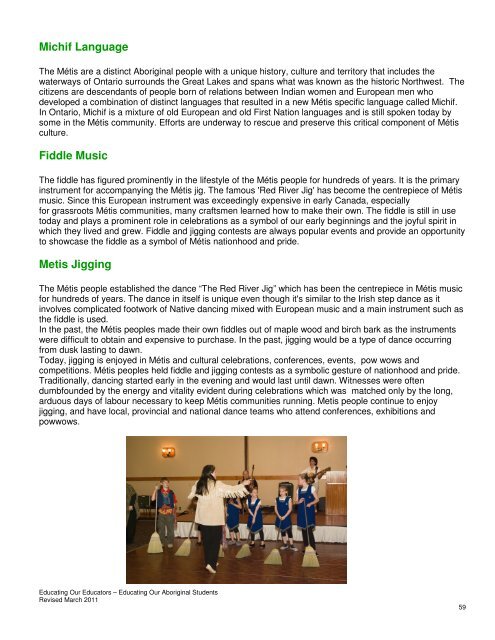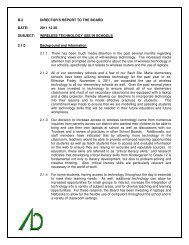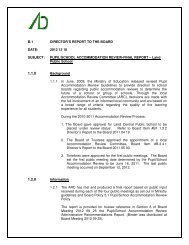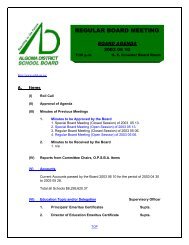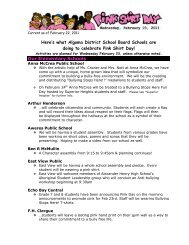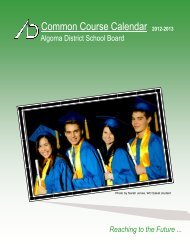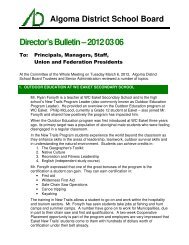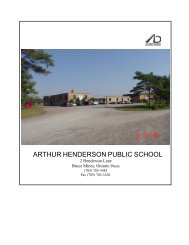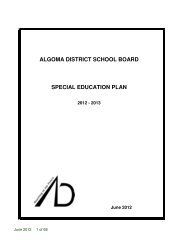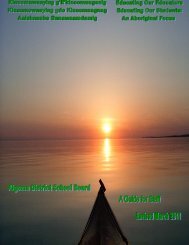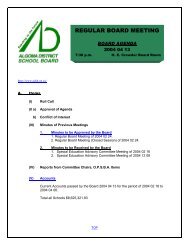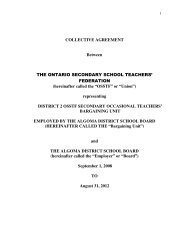Educating Our Educators Guide for Staff - Algoma District School ...
Educating Our Educators Guide for Staff - Algoma District School ...
Educating Our Educators Guide for Staff - Algoma District School ...
- No tags were found...
You also want an ePaper? Increase the reach of your titles
YUMPU automatically turns print PDFs into web optimized ePapers that Google loves.
Michif LanguageThe Métis are a distinct Aboriginal people with a unique history, culture and territory that includes thewaterways of Ontario surrounds the Great Lakes and spans what was known as the historic Northwest. Thecitizens are descendants of people born of relations between Indian women and European men whodeveloped a combination of distinct languages that resulted in a new Métis specific language called Michif.In Ontario, Michif is a mixture of old European and old First Nation languages and is still spoken today bysome in the Métis community. Ef<strong>for</strong>ts are underway to rescue and preserve this critical component of Métisculture.Fiddle MusicThe fiddle has figured prominently in the lifestyle of the Métis people <strong>for</strong> hundreds of years. It is the primaryinstrument <strong>for</strong> accompanying the Métis jig. The famous 'Red River Jig' has become the centrepiece of Métismusic. Since this European instrument was exceedingly expensive in early Canada, especially<strong>for</strong> grassroots Métis communities, many craftsmen learned how to make their own. The fiddle is still in usetoday and plays a prominent role in celebrations as a symbol of our early beginnings and the joyful spirit inwhich they lived and grew. Fiddle and jigging contests are always popular events and provide an opportunityto showcase the fiddle as a symbol of Métis nationhood and pride.Metis JiggingThe Métis people established the dance “The Red River Jig” which has been the centrepiece in Métis music<strong>for</strong> hundreds of years. The dance in itself is unique even though it's similar to the Irish step dance as itinvolves complicated footwork of Native dancing mixed with European music and a main instrument such asthe fiddle is used.In the past, the Métis peoples made their own fiddles out of maple wood and birch bark as the instrumentswere difficult to obtain and expensive to purchase. In the past, jigging would be a type of dance occurringfrom dusk lasting to dawn.Today, jigging is enjoyed in Métis and cultural celebrations, conferences, events, pow wows andcompetitions. Métis peoples held fiddle and jigging contests as a symbolic gesture of nationhood and pride.Traditionally, dancing started early in the evening and would last until dawn. Witnesses were oftendumbfounded by the energy and vitality evident during celebrations which was matched only by the long,arduous days of labour necessary to keep Métis communities running. Metis people continue to enjoyjigging, and have local, provincial and national dance teams who attend conferences, exhibitions andpowwows.<strong>Educating</strong> <strong>Our</strong> <strong>Educators</strong> – <strong>Educating</strong> <strong>Our</strong> Aboriginal StudentsRevised March 201159


